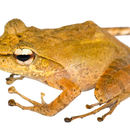Description
provided by AmphibiaWeb articles
M 47-53 mm, F 48 mm. One of the largest species in the subgenus Duboimantis. Distinguishable by the distinct but weakly expressed interocular tubercles, absence of other tubercles and ridges, distinct and large femoral glands, and relatively short hindlimbs, the tibiotarsal articulation not reaching beyond snout tip, often reaching only the eye or nostril.Similar species: G. cornutus has longer hind legs (tibiotarsal articulation reaches beyond tip of snout), conspicuous black tubercles between the eyes, smaller femoral glands and a smaller body size. In G. granulatus, the tibiotarsal articulation reaches beyond tip of snout, vocal sacs are paired and the two black tubercles between the eyes are not present.Taken with permission from Glaw and Vences (2007).
Glaw, F. and Raxworthy, C. (2008). Gephyromantis redimitus. In: IUCN 2008. 2008 IUCN Red List of Threatened Species. www.iucnredlist.org. Downloaded on 18 March 2009.
- author
- Miguel Vences
- author
- Frank Glaw
Distribution and Habitat
provided by AmphibiaWeb articles
Ambanizana, Ambatovaky, Ambohitsara, Ambolokopatrika corridor, An’Ala, Anjanaharibe, Besariaka, Brickaville, forest near Andranofotsy, Mananara, Mangevo (Ranomafana), Marojejy, Nosy Boraha, Nosy Mangabe, Sahembendrana, Vohidrazana (Glaw and Vences 2007).This species is found both on the ground and in trees, usually near streams in pristine rainforest and is not found in altered habitats. It has been observed from sea level up to 850m (Glaw and Raxworthy 2008).
- author
- Miguel Vences
- author
- Frank Glaw
Life History, Abundance, Activity, and Special Behaviors
provided by AmphibiaWeb articles
Habits: Males call at dusk and night from perches 1-2 m above the ground in vegetation along streams in rainforest.Calls: Very characteristic guttural unharmonious notes. Often only single notes are emitted after regular intervals, sometimes notes are arranged in series.Eggs and tadpoles: Unknown, probably not direct development.
- author
- Miguel Vences
- author
- Frank Glaw
Life History, Abundance, Activity, and Special Behaviors
provided by AmphibiaWeb articles
This species is listed as least concern in view of its wide distribution, presumed large population, and because it is unlikely to be declining fast enough to qualify for listing in a more threatened category. However, its forest habitat is receding due to subsistence agriculture, timber extraction, charcoal manufacture, and invasive spread of eucalyptus, livestock grazing and expanding human settlements. There is probably little habitat left in the southern part of its range (Glaw and Raxworthy 2008).
- author
- Miguel Vences
- author
- Frank Glaw
Gephyromantis redimitus
provided by wikipedia EN
- license
- cc-by-sa-3.0
- copyright
- Wikipedia authors and editors
Gephyromantis redimitus: Brief Summary
provided by wikipedia EN
Gephyromantis redimitus, commonly known as the banded Madagascar frog, is a species of frog in the family Mantellidae. It is endemic to Madagascar. Its natural habitat is subtropical or tropical moist lowland forests. It is threatened by habitat loss.
- license
- cc-by-sa-3.0
- copyright
- Wikipedia authors and editors

